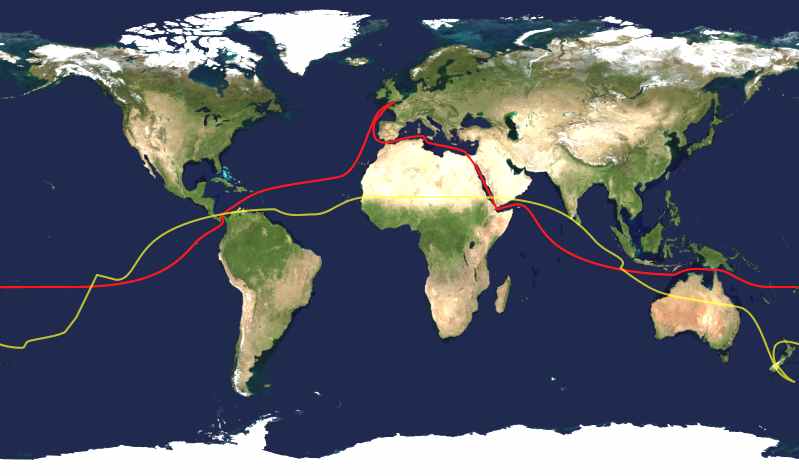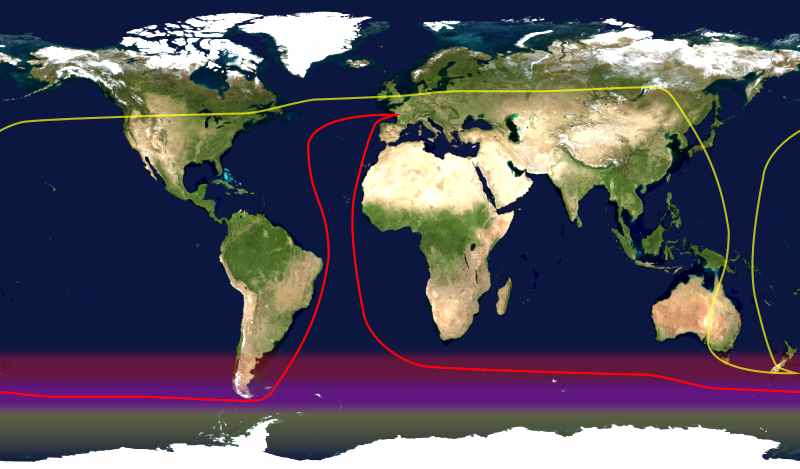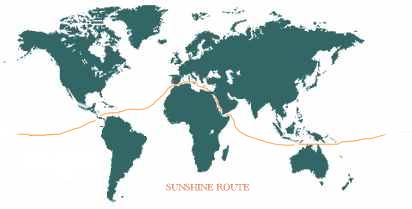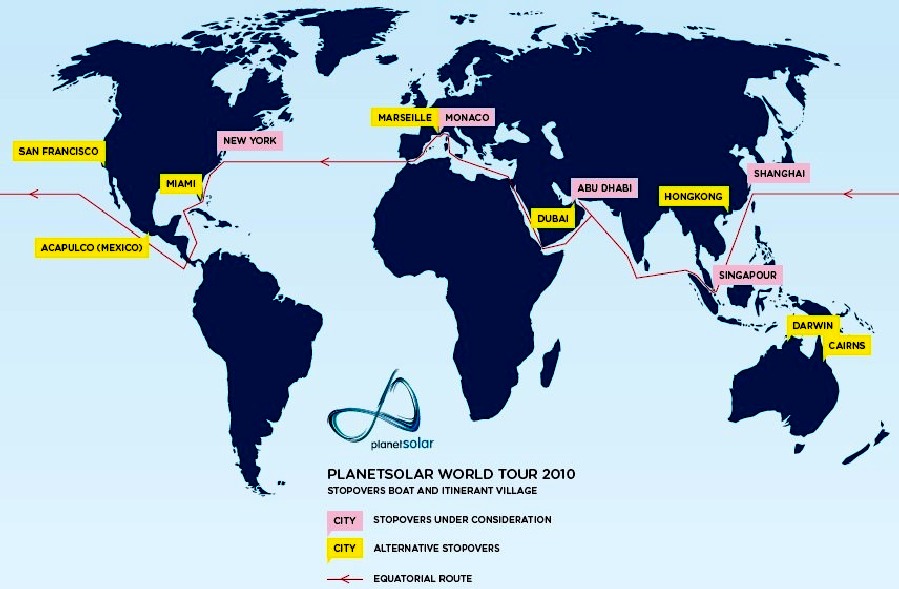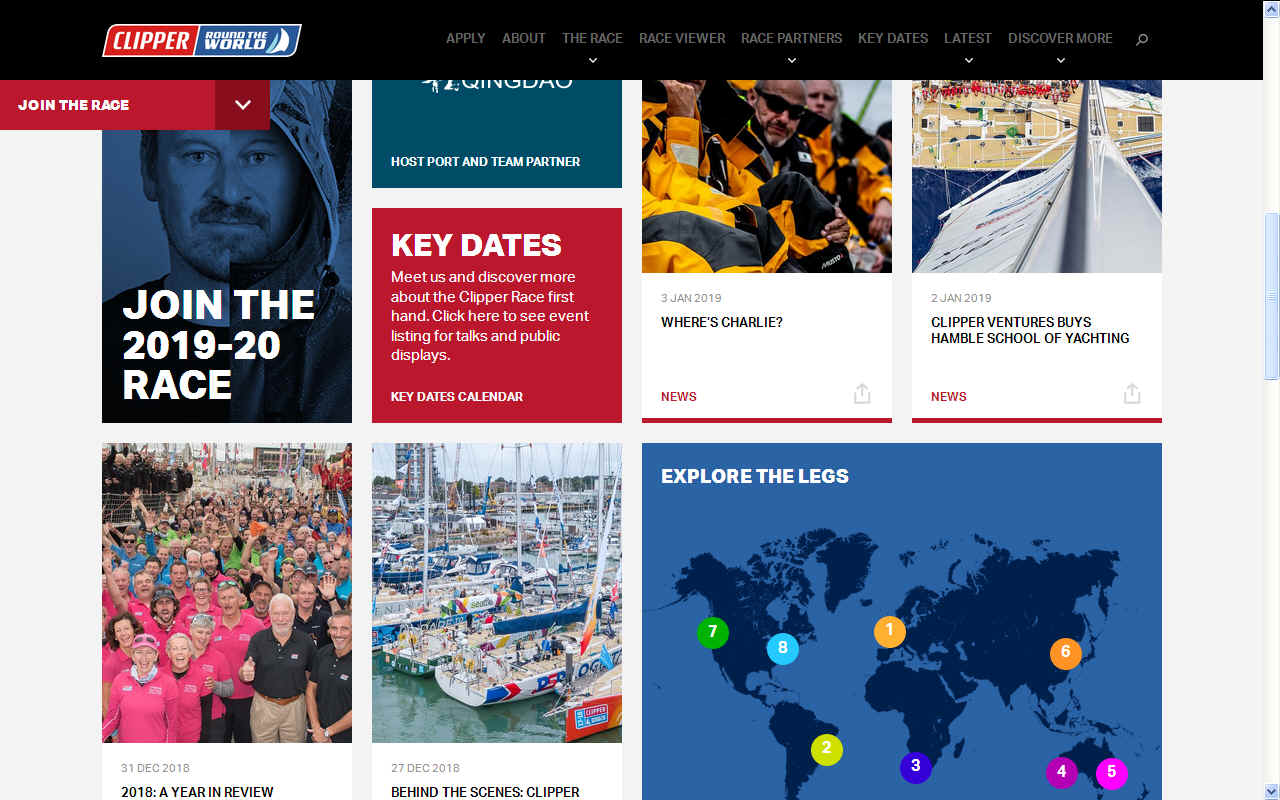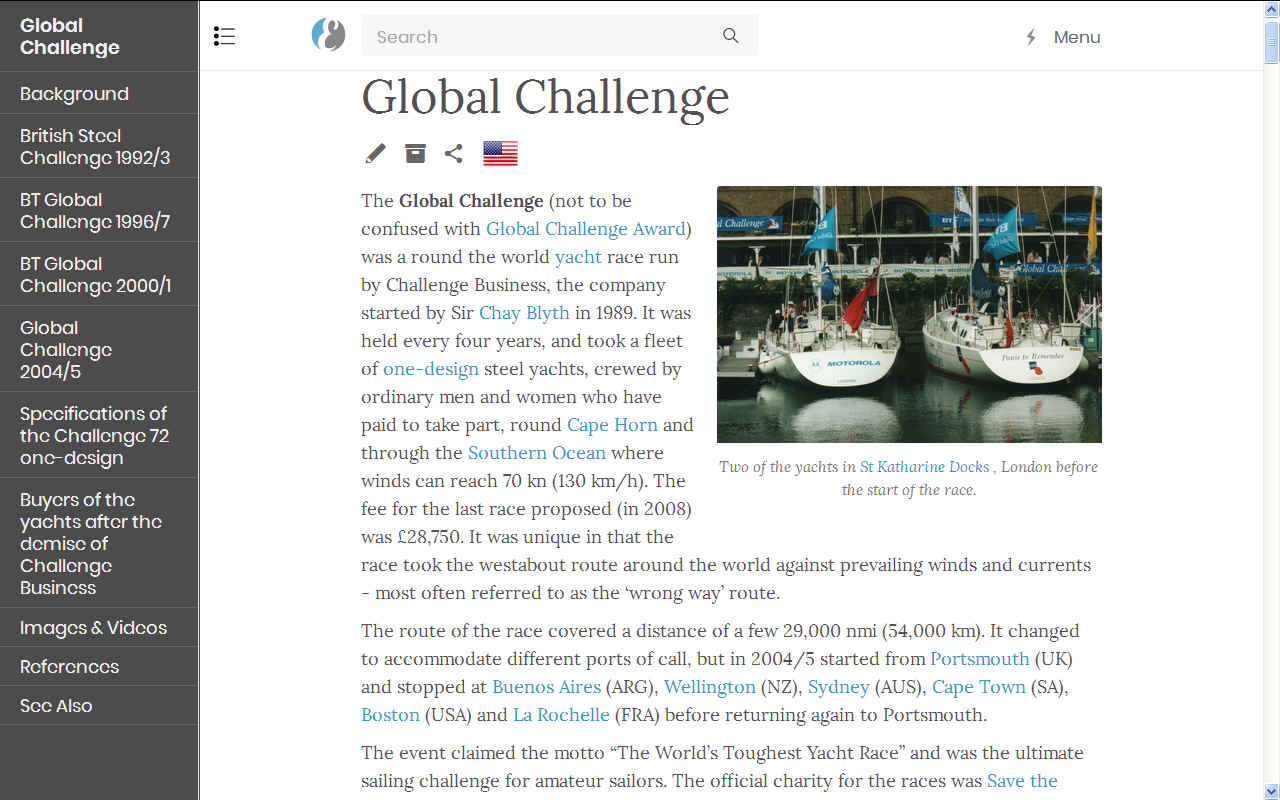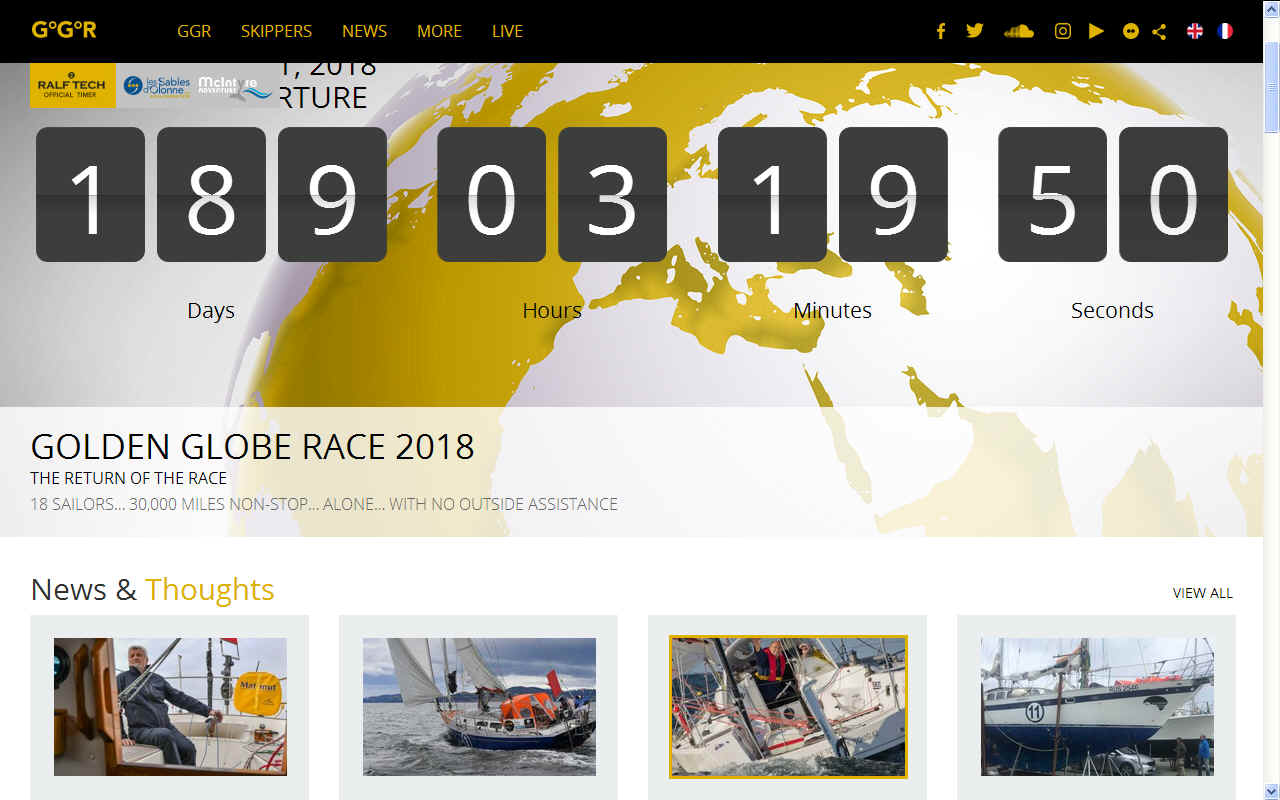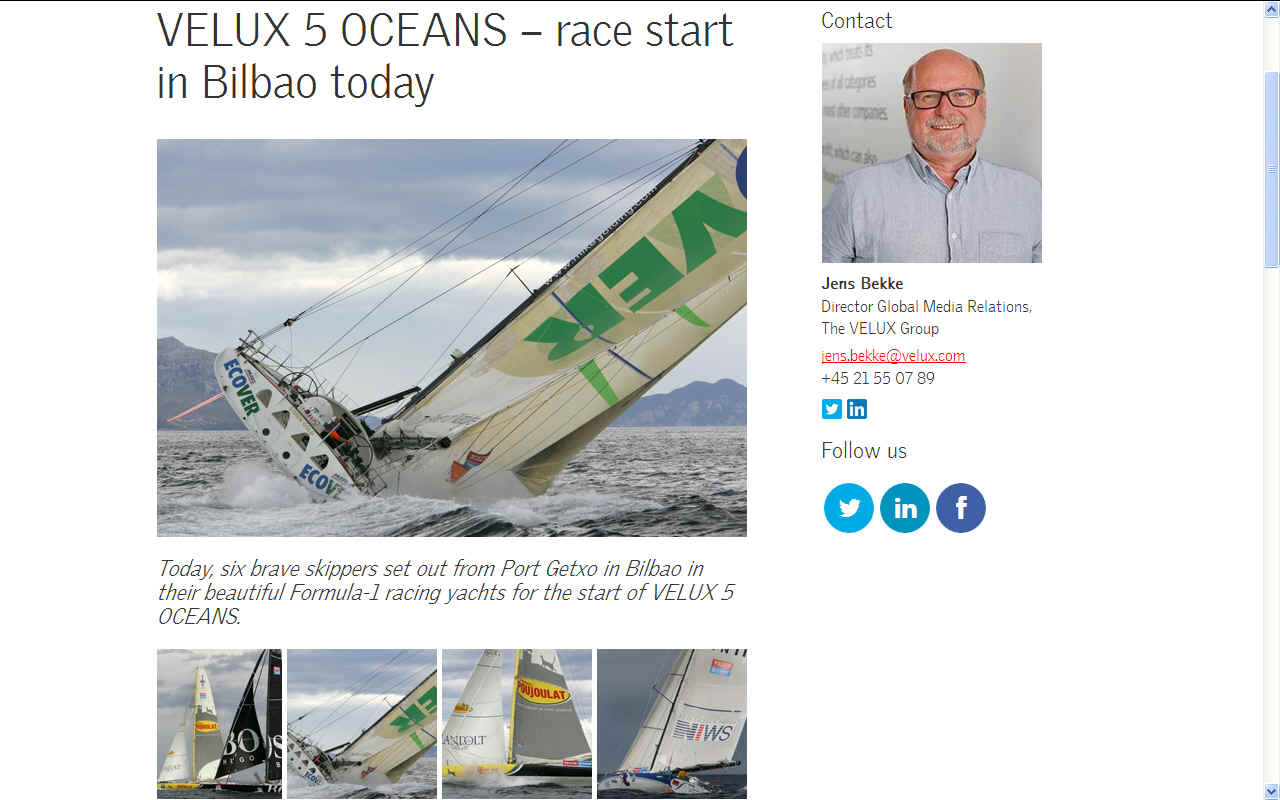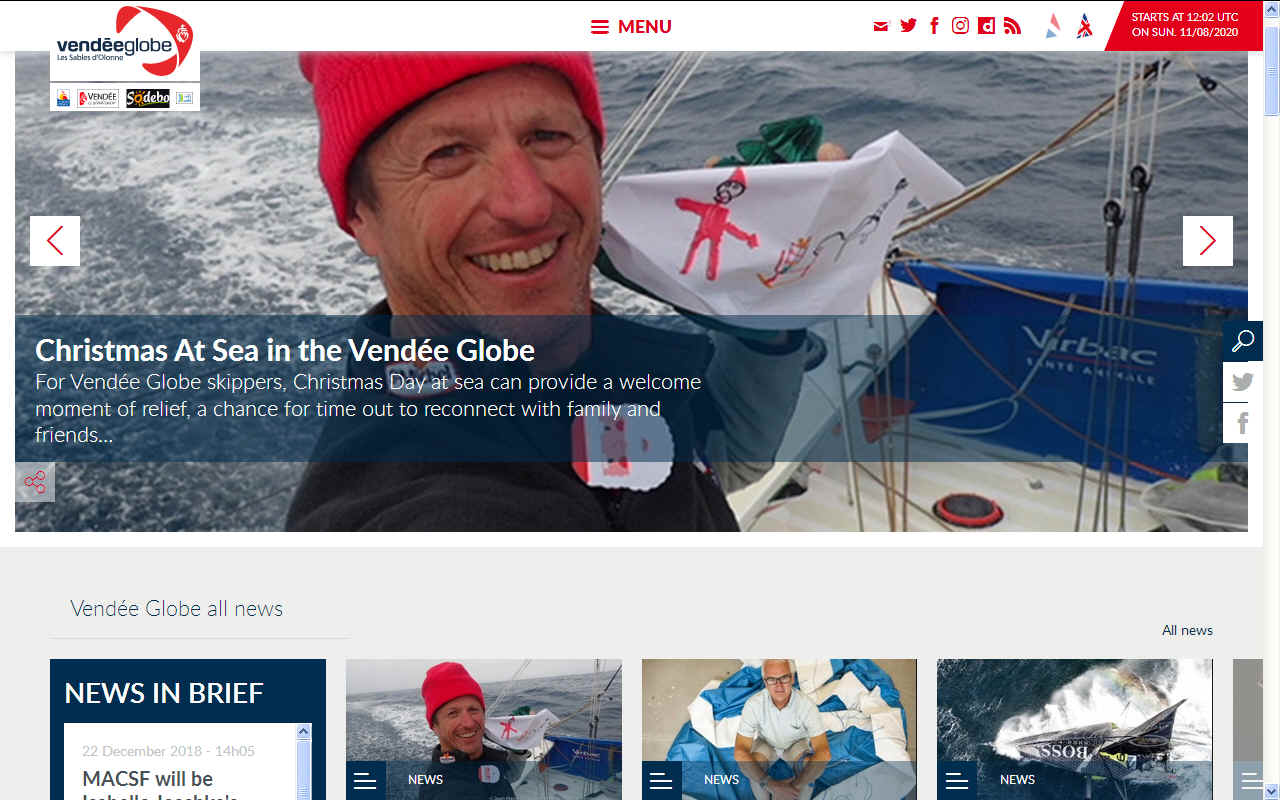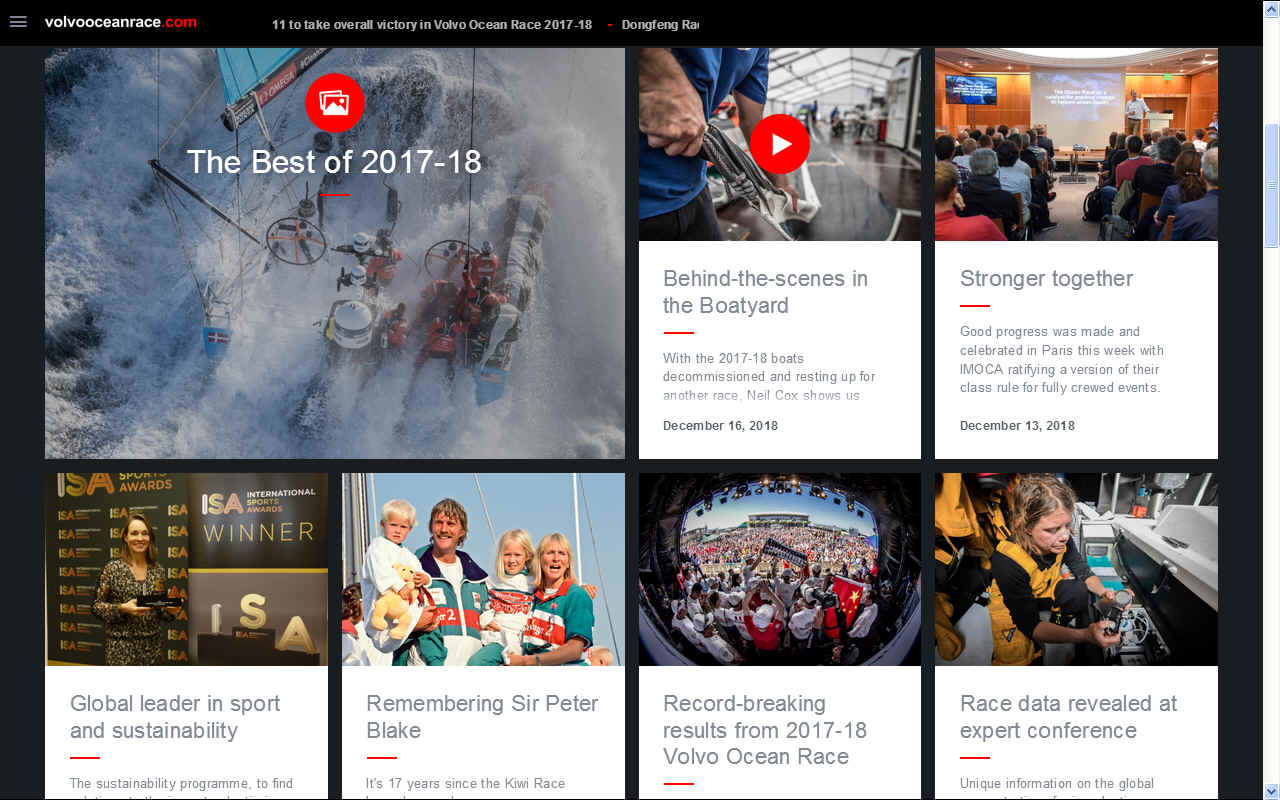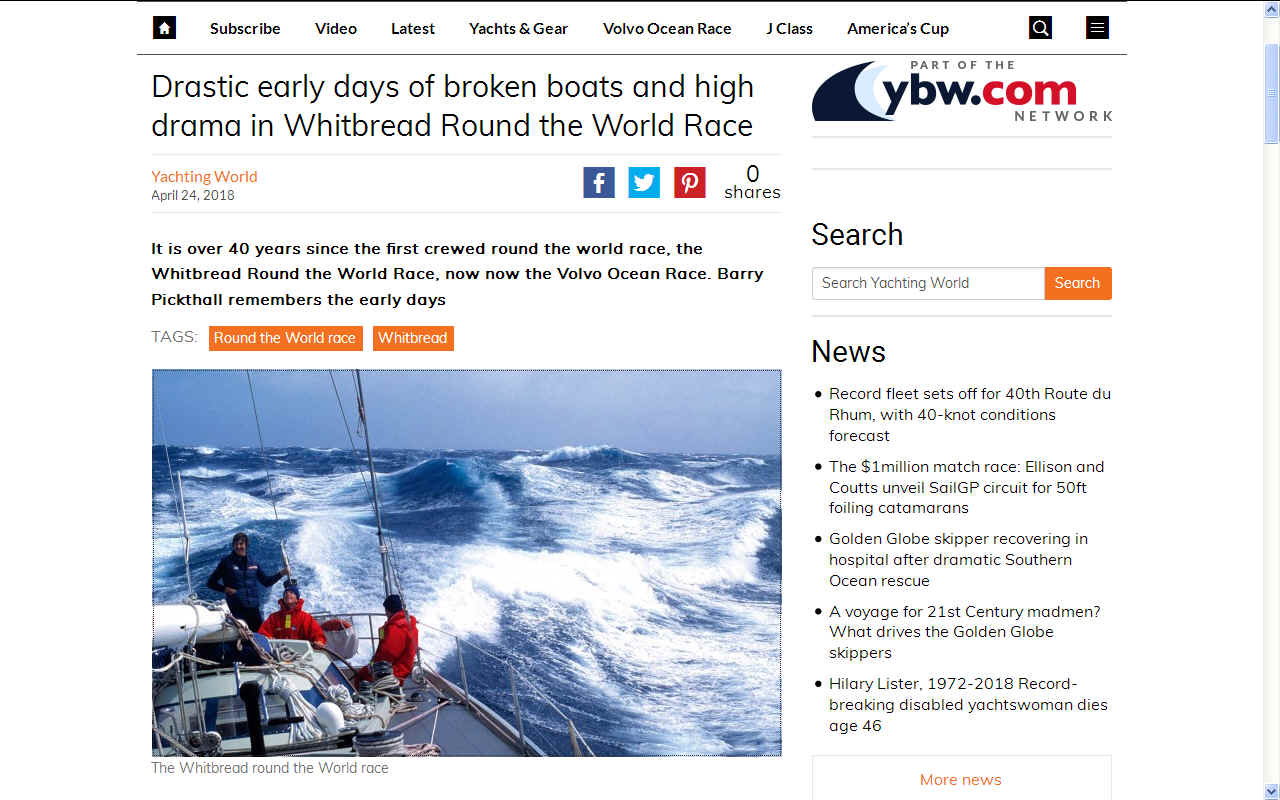CIRCUMNAVIGATION
To circumnavigate a place, such as an island, a continent, or the Earth, is to travel all the way around it by boat or ship. More recently, the term has also been used to cover aerial round-the-world flights.
Route of a typical modern sailing circumnavigation, via the Suez Canal
and the Panama Canal is shown in red; its antipodes are shown in yellow
World circumnavigation
A basic definition of a world circumnavigation would be a route which covers at least a great circle, and in particular one which passes through at least one pair of points antipodal to each other. In practice, different definitions of world circumnavigation are used, in order to accommodate practical constraints depending on the method of circumnavigation.
Nautical
The map on the right shows, in red, a typical sailing circumnavigation of the world by the trade winds and the Suez and Panama canals; overlaid in yellow are the points antipodal to all points on the route. It can be seen that the route roughly approximates a great circle, and passes through two pairs of antipodal points. This is a route followed by many cruising sailors; the use of the trade winds makes it a relatively easy sail, although it passes through a number of zones of calms or light winds.
In yacht racing, a round-the-world route approximating a great circle would be quite impractical, particularly in a non-stop race where use of the Panama and Suez Canals would be impossible. Yacht racing therefore defines a world circumnavigation to be a passage of at least 21,600 nautical miles (40,000 km) in length which crosses the equator, crosses every meridian in the same direction and finishes in the same port as it starts. The map on the left shows the route of the Vendée Globe round-the-world race in red; overlaid in yellow are the points antipodal to all points on the route. It can be seen that the route does not pass through any pairs of antipodal points. Since the winds in the lower latitudes predominantly blow west-to-east it can be seen that there is an easier route (west-to-east) and a harder route (east-to-west) when circumnavigating by sail; this difficulty is magnified for square-rig vessels..
Since the advent of world cruises in 1922, by Cunard's Lanconia, thousands of people have completed circumnavigations of the globe at a more leisurely pace. Typically, these voyages begin in New York City or Southampton, and proceed westward. Routes vary, either travelling through the Caribbean and then into the Pacific Ocean via the Panama Canal, or around Cape Horn. From there ships usually make their way to Hawaii, the islands of the South Pacific, Australia, New Zealand, then northward to Hong Kong, South East Asia, and India. At that point, again, routes may vary: one way is through the Suez Canal and into the Mediterranean; the other is around the Cape of Good Hope and then up the west coast of Africa. These cruises end in the port where they began.
Route of a typical yacht racing circumnavigation shown in red; its antipodes in yellow
Aviation
Aviation records take account of the wind circulation patterns of the world; in particular the jet streams, which circulate in the northern and southern hemispheres without crossing the equator. There is therefore no requirement to cross the equator, or to pass through two antipodal points, in the course of setting a round-the-world aviation record. Thus, for example, Steve Fosset's global circumnavigation by balloon was entirely contained within the southern hemisphere.
For powered aviation, the course of a round-the-world record must start and finish at the same point and cross all meridians; the course must be at least 36,787.559 kilometres (22,858.729 mi) long (which is the length of the Tropic of Cancer). The course must include set control points at latitudes outside the Arctic and Antarctic circles.
In ballooning, which is totally at the mercy of the winds, the requirements are even more relaxed. The course must cross all meridians, and must include a set of checkpoints which are all outside of two circles, chosen by the pilot, having radii of 3,335.85 kilometres (2,072.80 mi) and enclosing the poles (though not necessarily centred on them).
Surface Travel
There is one successful polar circumnavigation journey; tracing a great circle around the globe 'vertically' i.e. through both poles. Sir Ranulph Fiennes, Charles Burton and their team successfully completed the Transglobe Expedition between 1979 and 1982. Transglobe was the first polar circumnavigation by surface travel, touching two true antipodes: the two poles of the Earth. They approximated the great circle passing through Greenwich, covering 52,000 miles in the process. "To the Ends of the Earth" is the classic book which describes this journey.
Solar Powered
The map below shows the proposed route of the Elizabeth Swan, a solar powered electric boat in which it is hoped to break the existing record for an electric circumnavigation, presently held by the Turanor PlanetSolar, set in May of 2012 by Raphael Domjan and his crew with generous support from Immo Stroeher.
The Elizabeth Swan's - Sunshine Route
|
1. |
|
|
|
2. |
DAY 14 UPDATE |
|
|
3. |
DAY 28 UPDATE |
|
|
4. |
DAY 42 UPDATE |
|
|
5. |
DAY 56 UPDATE |
|
|
6. |
DAY 70 UPDATE |
|
|
7. |
DAY 84 UPDATE |
|
|
8. |
DAY 98 LATEST |
|
|
9. |
DAY 112 UPDATE |
|
|
10. |
DAY 126 UPDATE |
|
|
11. |
DAY 140 UPDATE |
|
|
12. |
DAY 154 UPDATE |
|
|
13. |
DAY 168 UPDATE |
|
|
14. |
DAY 182 UPDATE |
|
|
15. |
DAY 196 LATEST |
|
|
16. |
DAY 210 UPDATE |
|
|
17. |
DAY 224 UPDATE |
|
|
18. |
DAY 238 UPDATE |
|
|
19. |
DAY 252 UPDATE |
|
|
20. |
DAY 266 UPDATE |
|
|
- |
|
HOMECOMING |
Human Powered
Thomas Stevens was the first person to circle the globe by bicycle. The feat was accomplished between 1884 and 1886. While impressive at the time, a good portion of the trip was by steamer due to technical and political reasons.
To date no one has completed a human powered circumnavigation according to the guidelines set by Guinness World Records. However, in 2006, Colin Angus and Julie Wafaei completed a circumnavigation of the northern hemisphere entirely by human power, although Julie was with him for only part of the trip as she finished what Tim Harvey had started. Although Angus did not cross the equator, National Geographic Adventure Magazine honored Angus' achievement in human powered circumnavigation.
According to his Expedition 360 website, Jason Lewis is on track to complete the first antipodal circumnavigation by human power, but since his trip has involved non human powered travel between legs it still does not qualify under the Guinness rules as human powered circumnavigation.
Notable global maritime circumnavigations
-
Ferdinand Magellan, 1511–1521 (multiple voyages). In 1511 he visited the Moluccas (3°9′S 129°23′E). He returned to Portugal and set out in 1519 to circumnavigate the globe. He discovered and sailed through the Strait of Magellan and reached the Philippines in 1521, where he was killed on Cebu (10°5′S 123°33′E). It should be noted, however, that Magellan did not personally complete a circumnavigation of the Earth, as was once often erroneously taught to school children.
-
Enrique of Malacca, ?–1521, Magellan's interpreter (multiple voyages). He was captured in Sumatra as a child and taken to the Moluccas where he was sold to Magellan in 1511; he accompanied Magellan on his circumnavigation and ended up on Cebu in the Philippines.
-
The 18 survivors of Ferdinand Magellan's expedition (which began with 5 ships and 200 men), 1519–1522, in the Victoria. After Magellan died in the Philippines in 1521, the circumnavigation was completed under the command of the Basque seafarer Juan Sebastián Elcano who returned to Seville on 8 September 1522 after a journey of 3 years and 1 month. They were the first to circumnavigate the globe in a single expedition.
-
The survivors of García Jofre de Loaysa's Spanish expedition, 1525–1536. None of Loaysa's seven ships completed the voyage, but Santa María de la Victoria reached the Moluccas before being wrecked in a Portuguese attack. Fernando de la Torre and eight survivors return to Spain on a Portuguese ship.
-
Andrés de Urdaneta, another Basque, completed a nine-year journey circumnavigating the globe in 1528.
-
Francis Drake, 1577–1580, in Golden Hind. Discovered the Drake Passage but entered the Pacific via the Strait of Magellan.
-
Thomas Cavendish, 1586–1588, in Desire.
-
The survivors of the expeditions of Jacques Mahu and Olivier van Noort, 1598–1601. Of Mahu's five and Van Noort's four ships only two returned.
-
George Spilberg, 1614–1617.
-
Willem Schouten and Jacob Le Maire, 1615–1617 in Eendraght. Discovered Cape Horn; the first expedition to enter the Pacific via the Drake Passage.
-
Jacob l'Hermite and John Hugo Schapenham, 1623–1626.
-
Giovanni Francesco Gemelli Carreri, 1693–1698. The first tourist to circumnavigate the globe, paying his own way on multiple voyages, crossing Mexico on land.
-
William Dampier (English) 1679–1691; 1703–1707; and 1708–1711. First person to circumnavigate the world twice.
-
George Anson, 1st Baron Anson, 1740–1744, in HMS Centurion.
-
John Byron, 1764–1766, in HMS Dolphin. First circumnavigation in less than two years.
-
Samuel Wallis and Philip Carteret, 1766–1768, in Dolphin and HMS Swallow. Carteret had served on Byron's expedition. Dolphin was the first ship to survive two circumnavigations.
-
Louis de Bougainville, 1766–1769 On board was Jeanne Baré, disguised as a man, the first woman the circumnavigate the globe.
-
James Cook, 1768–1771, in HMS Endeavour. The first circumnavigation to lose no personnel to scurvy.
-
Tobias Furneaux, 1772–1774, in HMS Adventure. The first circumnavigation from west to east. (Furneaux was a veteran of Byron's expedition so he was also the first person to circumnavigate in both directions.)
-
James Cook, 1772–1775 in HMS Resolution.
-
Robert Gray, 1787–1790, first American circumnavigation.
-
Adam Johann von Krusenstern, 1803–1806 first Russian circumnavigation.
-
Robert Fitzroy, 1831–1836, in HMS Beagle with Charles Darwin.
-
The first Galathea expedition, 1845–1847, first Danish circumnavigation.
-
Casto Méndez Núñez, 1865–1868, aboard Numancia, first ironclad warship circumnavigation.
-
Joshua Slocum, 1895–1898, first single-handed circumnavigation.
-
The Great White Fleet, 1907–1909, first fleet to circumnavigate the world
-
Harry Pidgeon, 1921–1925 1932–1937, second single-handed circumnavigation, first person to circumnavigate solo twice.
-
USS Triton, 1960 first underwater circumnavigation.
-
Irving Johnson, 1934–1958, sail training pioneer together with his wife Electa "Exy" Johnson, circumnavigated the world 7 times with amateur crews.
-
Robin Lee Graham, 1965-c. 1970, youngest at the time (at age 16-21) solo circumnavigation aboard 24' sailboat Dove.
-
Sir Francis Chichester, 1966–1967, first single-handed circumnavigation with just one port of call.
-
Robin Knox-Johnston, 1968–1969, first single-handed non-stop circumnavigation.
-
Chay Blyth, 1971, first westwards single-handed non-stop circumnavigation.
-
Krystyna Chojnowska-Liskiewicz, 1976–1978, first woman to perform a single-handed circumnavigation.
-
Naomi James, 1977–1978, first woman to perform a single-handed circumnavigation via Cape Horn.
-
Marvin Creamer (USA), December 21, 1982 – May 17, 1984, only known person to circumnavigate the globe by boat with no nautical aids, not even a compass or watch [1].
-
Teddy Seymour, 1987, the first African-American to complete solo single-handed circumnavigation, aboard sailboat Love Song.
-
Tania Aebi, 1985–1987, American woman who completed a solo circumnavigation by the age of 20, one 80 nautical mile stretch with crew disqualified her from an official record.
-
Kay Cottee, 1988, first woman to perform a solo non-stop circumnavigation.
-
Jesse Martin, 1999, youngest person (aged 17-18 years) to perform a solo non-stop circumnavigation.
-
Bruno Peyron, 2005, set current wind powered circumnavigation record, 50 days, 16 hours, 20 minutes, aboard maxi catamaran Orange II.
-
Dee Caffari, 2006, first woman to perform a solo westabout non-stop circumnavigation, in 178 days.
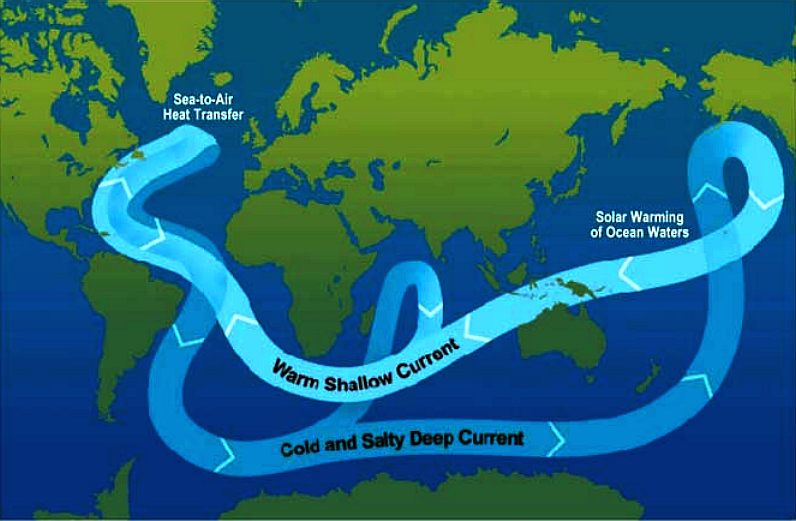
Other notable maritime circumnavigations
-
Phoenician expedition sent by Pharaoh Necho II, c. 600 BC, first circumnavigation of Africa.
-
Roman Governor Gnaeus Julius Agricola, c. 80, first circumnavigation of Britain.
-
Jacques Cartier, 1534–1535, first circumnavigation of Newfoundland.
-
García de Nodal, 1619, first circumnavigation of Tierra del Fuego.
-
James Cook, 1769–1770, first circumnavigation of New Zealand.
-
Matthew Flinders, 1801–1803, first circumnavigation of Australia.
-
Adolf Erik Nordenskiöld, 1878–1879, first circumnavigation of Eurasia.
-
RCMP St Roch — first vessel to circumnavigate North America. 1940-1942, Vancouver to Halifax, Nova Scotia, via the Northwest Passage. 1950, Halifax to Vancouver, via the Panama Canal.
-
HMCS Labrador, 1954, first vessel to circumnavigate North America in a single voyage.
Record maritime circumnavigations
-
Bruno Peyron (French), January–March 2005, fastest circumnavigation 50 days 16 hours 20 minutes 4 seconds.
-
Jean Luc van den Heede (French), 2004, fastest westward single-handed circumnavigation, 122 days 14 hours 3 minutes 49 seconds.
-
Adrienne Cahalan (Australian), February-March 2004, fastest woman to complete a circumnavigation (crew of "Cheyenne") 58 days 9 hours 32 minutes 45 seconds
-
Ellen MacArthur (English), 2004–2005, fastest single-handed 71 days 14 hours 18 minutes 33 seconds.
-
Jon Sanders holds the world record for completing a single-handed triple circumnavigation.
-
The RMS Queen Mary 2, at 148,528 gross tons, became the world's largest passenger ship to circumnavigate the globe during her 2007 world cruise.
Notable aerial circumnavigations
-
United States Army Air Service, 1924, first aerial circumnavigation, 175 days, covering 44,360 kilometres (27,553 miles).
-
LZ-127 Graf Zeppelin, 1929, piloted by Hugo Eckener set a record for the fastest aerial circumnavigation, 21 days, which was also the first circumnavigation in an airship.
-
On July 1, 1931, pilot Wiley Post and navigator Harold Gatty completed their circumnavigation of the world in a Lockheed Vega aeroplane, Winnie Mae, in 8 days, 15 hours and 51 minutes; the record for fastest circumnavigation was once again held by an aeroplane.
-
In 1932 Wolfgang von Gronau flew around the World with a twin engine Dornier seaplane, Gronland-Wal D-2053, in nearly four months, making 44 stops en route. He was accompanied by co-pilot Gerth von Roth, mechanic Franzl Hack, and radio operator Frtiz Albrecht.
-
In 1933 Wiley Post repeated his circumnavigation by aeroplane, but this time solo, using an autopilot and radio direction finder. He made the first solo aerial circumnavigation in a time one day faster than his previous record: 7 days, 19 hours, 49 minutes, in which he covered 25,110 kilometres (15,596 mi).
-
In 1949 the United States Air Force B-50 Superfortress Lucky Lady II made the first non-stop aerial circumnavigation in 94 hours and 1 minute. Four in-air refuelings were required for the flight, which covered 37,743 kilometres (23,452 mi).
-
In 1961 Yuri Gagarin made the first human flight in space, and completed the first orbit of the Earth, in Vostok 1.
-
Geraldine Mock, 1964, first woman to complete a solo aerial circumnavigation.
-
Don Taylor, 1976, first general aviation circumnavigation by homebuilt aircraft.
-
Dick Rutan and Jeana Yeager, 1986, Voyager, first non-refueled circumnavigation in an airplane, 9 days, 3 minutes and 44 seconds.
-
Bertrand Piccard and Brian Jones, 1999, first non-stop balloon circumnavigation in Breitling Orbiter 3, 19 days, 1 hour and 49 minutes, covering 42,810 kilometres.
-
Polly Vacher, 2001, in the smallest aircraft flown in a solo circumnavigation by a woman, via Australia and the Pacific.
-
Steve Fossett, 2 July 2002, first solo balloon circumnavigation.
-
Steve Fossett, 3 March 2005, first non-stop, non-refueled solo circumnavigation in an airplane, 67 hours, covering 37,000 kilometres.
-
Steve Fossett, 11 February 2006, longest non-stop, non-refueled solo flight (with circumnavigation) in an airplane, covering 42,469.5 kilometres (26,389.3 mi), in 76 hours and 45 minutes.
Fictional circumnavigations
The most famous circumnavigation never happened. This is the story told in Jules Verne's 1872 science fiction novel, Around the World in Eighty Days. Upper class Englishman Phileas Fogg and his servant Passerpartou use a variety of transportation means and ingenuity to accomplish the adventurous feat. The book was freely adapted by Mike Todd into an Academy Award winning movie of the same name in 1956, starring David Niven and Cantinflas. The book (especially) and the movie are tributes to the new transportation possibilities of the early Industrial Revolution, with the coming of steamships, railways, etc. As this circumnavigation did not cross the Equator or reach antipodal points, it would not have been recognized by Guinness Records as an official circumnavigation (if such a thing had existed at that time).
Another fictional circumnavigation is in the Kulo-Luna novel by Jameson Hunter. In this story there is a race around the world by solar powered boats, of which one boat, the SolarNavigator abandons the race to try to save a humpback whale in distress.
Drake's circumnavigation - Youtube
|
Severe storm - Youtube
|
||
Volvo Ocean Race - Youtube
|
Gypsy Moth relived - Youtube
|
||
Francis Chichester 1967 - Youtube
|
Whitbread world race 1989 - Youtube
|
||
Ellen MacArthur preparations - Youtube
|
Ellen MacArthur record - Youtube
|
LINKS
-
Steven Dutch, Circumnavigations of the Globe to 1800
-
Some Notable Around-the-World and Intercontinental Trips from the History Channel
-
World Sailing Speed Record Council Rules 2005-2008, sec. 26, Record Courses
-
FAI Sporting Code Section 2: Powered Aerodynes: Speed around the world non-stop and non-refuelled
-
FAI Sporting Code Section 1: Aerostats: Around-the-World Records
-
Colin Angus, Beyond the Horizon: The Great Race to Finish the First Human Powered Circumnavigation of the Planet; Toronto: Doubleday Canada, 2007
-
Kurlansky, Mark. 1999. The Basque History of the World. Walker & Company, New York. ISBN 0-8027-1349-1, p. 63
-
Kurlansky, Mark. 1999. The Basque History of the World. Walker & Company, New York. ISBN 0-8027-1349-1, p. 64
-
wrong-way sailor back on UK soil, BBC News.
-
Round-the-World Flights, from WingNet.
-
Fossett flies to non-stop record, from BBC News.
-
Steve lands as an uninvited guest!, from Virgin Global Flyer.
-
White Ocean Racing - Spirit of Weymouth Vendee Globe 2008
ACIDIFICATION
- ADRIATIC
- ARCTIC
- ATLANTIC
- BALTIC
- BAY
BENGAL - BAY
BISCAY - BERING
- BLACK CARIBBEAN
- CORAL
- EAST
CHINA SEA
- ENGLISH
CH - GOC
- GUANABARA
- GULF
GUINEA - GULF
MEXICO INDIAN
-
IRC - MEDITERRANEAN
- NORTH
SEA - PACIFIC
- PERSIAN
GULF - SEA
JAPAN - STH
CHINA PLASTIC
- PLANKTON
- PLASTIC
OCEANS - SEA
LEVEL RISE - SOUTHERN
- UNCLOS
- UNEP
WOC
- WWF
This website is Copyright © 1999 & 2019 Max Energy Ltd. The bird logos and names Elizabeth Swan™, Kulo Luna™, SeaNet™, Seavax™ are trademarks. All rights reserved. Max Energy Ltd is an educational charity working hard for world peace.
